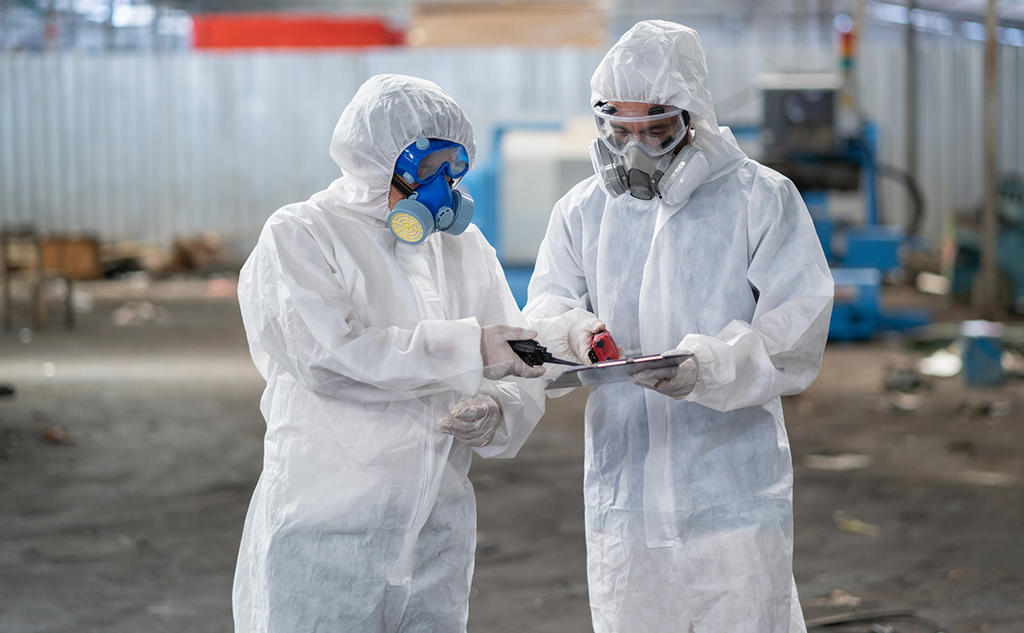The transition towards a lower-consumption and lower-impact economy is seeing the emergence of some particular risks. That’s the case for the circular economy, in particular for waste recycling. What are these risks? And how are they managed?
What’s the nature of the risks?
Overall, risks related to the ecological transition include new risks but also risks that already existed but which are evolving alongside technologies (for example, lithium-ion batteries, hydrogen, and nanotech such as nanopesticides, nanoparticles etc.) These risks are often complex and can be interlinked, plus they may have a particularly serious impact on health and on the environment. Also because of their nature, they are multiplying through the simple fact of increased exposure (for example, we’re using more and more batteries in our daily lives),
Risks specific to the circular economy
From the search for resources right through to product end-of-life, the circular economy includes many potential sources of risks. Here we will focus on those connected with recycling. Even before recycling begins, end-of-life products need to be prepared: safety measures must be taken (e.g. batteries), and the products dismantled, separated, sorted, crushed or shredded and so on – all operations that demand prior risk assessment. Then the recycling processes in their own right include mechanical, chemical, and sometimes biological stages which may themselves carry risk: process risk, (such as inflammability, explosion, electrostatic), health risks (worker exposure, environmental contamination, exposure of the local public, production of toxic substances) and environmental risks (environmental impacts – air, water, ground, ecotoxicity etc.). When these two stages are brought together (as is the case for an industrial and regional ecological approach), other risks may arise. Recycling may also produce primary materials derived from that recycling which, similarly, need to be subject to safety measures.
New recycling industries
Today, these industries are seeing rapid development – for example, for batteries or plastics, or for solar panels and recovering value from biomass. The earlier any risk management is tackled, the more these industries are able to develop sustainably. In this respect, the SEPAR8 project underway in the Hauts-de-France region in the north of France aims to create a “circular ecosystem around lithium batteries through short-loop organisation of their recycling and recovery”, and is symbolic because, according to Julie Albrecht, heading the Inéris Circular Economy project, “it spotlights risk management as a major challenge in the development of a circular battery industry”.
When it comes to plastics, this month – August 2024 – sees the achievement of the 5-year European “Circular Flooring” project to recycle PVC floor coverings after use by separating and eliminating critical additives such as phthalates, with the goal of recovering PVC compliant with EU legislation for use in new floor coverings. This process employs solvent-based recycling that eliminates the plasticisers coming from the waste. The PVC recovered this way complies with REACH legislation and can be used to produce new PVC floor coverings. Coordinated by the Fraunhofer Institute for Process Engineering and Packaging IVV (in Germany), the project involves eleven companies and research institutes in five countries: Austria, Belgium, France, Germany and Greece. On the French side, Inéris (the French National Institute for Industrial Environment and Risks) has focused particularly on regulatory analysis of hazardous chemical substances through a study of waste disposal and evaluation of process safety.
Still on the subject of plastics, Eastman Chemical Company in the US is backing development of a molecular recycling plant at Saint-Jean-de-Folleville, in the riverside Port-Jérôme II chemical park near Le Havre. This facility is set to recycle nearly 160,000 tonnes of high-polyester plastic waste through methanolysis, with the methanol acting as a solvent to break the plastic’s chemical bonds. Long-term it should yield 200,000 tonnes per year of recycled raw material. Since early July, this project has been classified by the French government (1) as a “project of major national interest”. As a reminder, methanol (methyl alcohol) is a stable chemical in normal use. However, mandatory regulatory occupational exposure limits have yet to be determined in France for air in workplaces (viz INRS MSDS no. 5). Further, a regulation appearing in 2016 prohibits methanol content from exceeding 0.6% in de-icing and defrosting liquids sold on the market. Like PVC floor tiles, collected PVC waste for now is mainly incinerated.
The risk of fire – one of the main recycling-related risks
If the risk of accidents related to the ageing (2) of some equipment is already documented and taken into account, a report on risk reduction drawn from waste management sector accidentology and drafted by IGEDD (the French General inspectorate for environment and sustainable development) and CGE has since early 2023 emphasised the need to reduce fire risk particularly related to the presence of batteries. According to BARPI (the French Bureau for Analysis of Industrial Risks and Pollutions)(3), accidentology of the waste sector (the highest rated of all industries, ahead of the chemical industry, agrifood, agriculture, metals processing, trade, transport & warehousing, energy production etc.) is primarily that of fires. These top the lists of observed incidents and are well ahead of those caused by hazardous or polluting material wastes and explosions.
Fires are above all a hazard for personnel working on these installations but may also have environmental and health impacts, and/or financial costs. This is the basis on which the multi-year strategic directions have been identified for the period 2023-2027. This essentially involves “improving accident management by implementing daily monitoring of waste inventory”. To deliver this a number of new French ministerial decrees have been implemented, covering around ten provisions of which some have already been in force since July 2024 (see box).
New provisions for improving the management of fire risk
Decrees from the end of 2023 have since 1st July 2024 encouraged the cleaning-up of unserviceable vehicles (for example, removing the battery), the production of a fire-fighting plan, running a fire drill at least every three years and providing disaster training for staff. They make mandatory the sorting of battery-powered WEEE alongside undertaking an inventory review to be performed daily for hazardous wastes, and weekly for other wastes, as from January 2025. They also require the creation of a temporary storage area for damaged vehicles or those presenting a fire risk, and an immersion facility (in the case of suspected or identified fire), to ensure the automated detection and monitoring of any fire outbreak or remote viewing, coupled with the organisation of patrols in areas housing combustible or flammable waste (as from January 2026). As of this deadline it will also be mandatory to create a procedure to identify upstream sorting errors and to take specific measures for construction materials, for islanding and battery storage.
The impacts of the circular economy on health and safety
According to the European Agency for Safety and Health at Work (EU-OSHA), the transition to a circular economy has not only significant political and regulatory repercussions affecting the employees of tomorrow, but will also have consequences for worker health and safety. For example, its implications for workers in risk sectors, relating to maintenance and repair, disassembly and recycling, may prove negative for working conditions or the development of organisational processes and/or the re-definition of tasks that may impact on the nature of roles and on workplace satisfaction.
In its role of contributing to safer and healthier working conditions in Europe, EU-OSHA is looking into the workplace changes that may ensue from the EU’s transition towards a circular economy and the possible impacts on health and safety at work (HSW). It’s now commencing its third foresight cycle. Following an initial phase that led to the creation of four macro-scenarios leading up to 2040, at the beginning of 2023 the Agency published a detailed report on the subject(4) and a number of associated guidance notes, among them “How to improve the outlook for the most impacted industries?” (construction, energy, manufacturing industry and transport). It has identified several types of risk depending on the scenarios and industries concerned: physical or safety risks (e.g. during the demolition of fossil-fuelled sites or the dismantling of old power stations); chemical hazards (e.g. during building renovation, or again the dismantling of old power stations); biological risks (related to the development of biotechnology which, for now, has low barriers to entry, hence possible malicious use). Ergonomic issues are also a concern: for remote working, workers may not necessarily have ergonomically-appropriate equipment at home; or perhaps psycho-social problems – as in an increasingly circular economy, while the environmental quality of living conditions improves, this could lead to greater resistance to stress and anxiety, but in remote working situations stress and anxiety levels may increase. All this work allows the EU-OSHA to anticipate developments that may impact HSW. The Agency is working on other emerging risks such as ICT and the digital transition, nanomaterials in the workplace and the health and safety of workers active in green jobs. It has just been updating the risks related to climate change, to include working in conditions of extreme heat etc.
1) The concept of “project of major national interest for the ecological transition or national sovereignty” is cited in article 19 of France’s Green Industry Law of 23 October 2023.
2) The ageing of an installation is not simply how old it is but also depends on other factors such as material properties, the degree of constraints and intensity of operating conditions, the operating environment, etc. These are all aspects that need to be anticipated, caught in good time and measured.
3) The French Bureau for Analysis of Industrial Risks and Pollutions, Barpi, is part of of the General Directorate for Risk Prevention (DGPR) within the Ministry for the Ecological Transition.
4) Foresight study on the circular economy and its effects on occupational safety and health, 122 pages, EU-OSHA, April 2023
Read More : The EU’s circular economy is taking shape,here’s how




